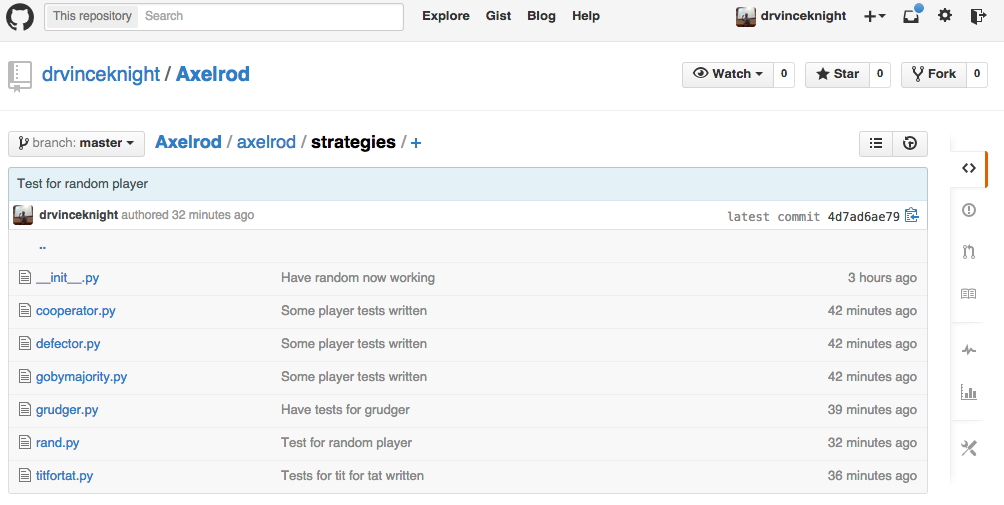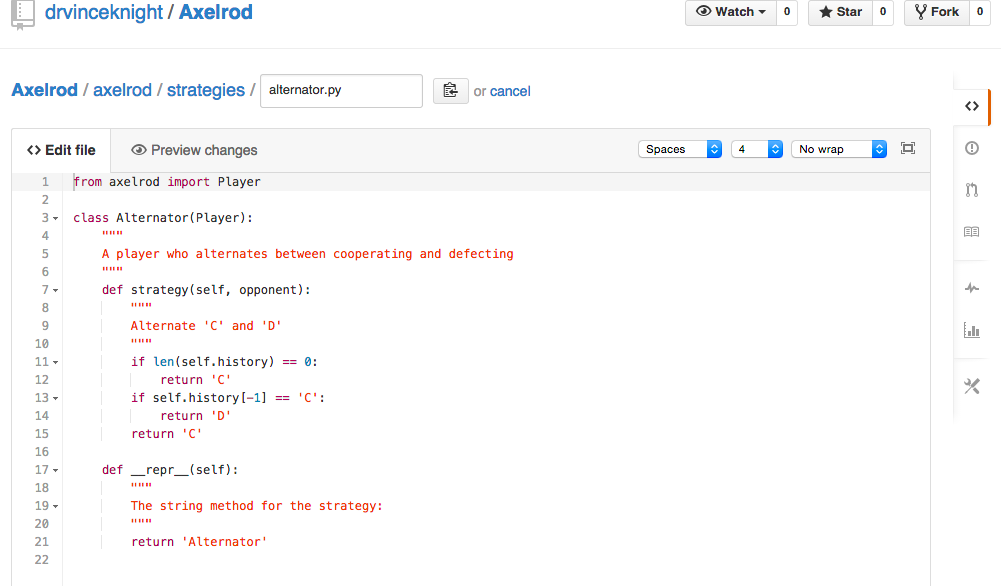An iterated prisoners dilemma on github
In the 1980s Axelrod ran a computer tournament inviting people to contribute code that specified strategies in an iterated prisoner’s dilemma tournament. I have just finished putting the final pieces on a Python repository on github (github.com/drvinceknight/Axelrod) to carry out the same tournament and would be delighted for people to contribute strategies via pull request (or indeed via any way possible: just get in touch). In this post I’ll describe the process of adding a strategy to the repository (the first 3 minutes of a video at the end of this post show you exactly what you are required to do).
For a good overview of the iterated prisoner’s dilemma take a look at this page about Axelrod’s tournament but in a nutshell the idea is that two players (prisoners) repeatedly play the following game:
If in a particular round they both cooperate (first row/column) they both accrue 2 years in prison. If one defects (second row/column) and the other cooperates: the defector gets 0 extra years in prison and the cooperator 5. If they both defect they each accrue 4 years in prison.
Axelrod’s tournament invited contribution of strategies that took account of the history of both players over several rounds. Thus a strategy that punished defectors would perhaps wait until a defection to do that (cooperating until then). The tournament was a round robin with the lowest total/mean years in prison being deemed the winner.
This tournament has often been used to describe how cooperation can emerge in a population: the tit for tat strategy (which starts by cooperating and then simply repeats the previous action) won! (In fact it won both times as the tournament was repeated.)
I have put together a github repository that allows anyone to contribute a strategy using Python to this tournament. You can find it here: https://github.com/drvinceknight/Axelrod.
At present I have only implemented 6 strategies and you can see the result here:

To contribute you really only need to write very simple python code. Here is the code for the tit for tat strategy:
from axelrod import Player
class TitForTat(Player):
"""
A player starts by cooperating and then mimics previous move by opponent.
"""
def strategy(self, opponent):
"""
Begins by playing 'C':
This is affected by the history of the opponent: the strategy simply repeats the last action of the opponent
"""
try:
return opponent.history[-1]
except IndexError:
return 'C'
def __repr__(self):
"""
The string method for the strategy.
"""
return 'Tit For Tat'That is more or less just 3 lines of code. I’ll now briefly describe adding another strategy to this repository (and I will do it entirely using the github web interface).
I am going to add a strategy called: ‘alternator’ which simply alternates strategies.
First I navigate to this url: https://github.com/drvinceknight/Axelrod/tree/master/axelrod/strategies:

Here I can just click on the + at the top of the page (after: Axelrod/axelrod/strategies/+).
As this is my own github repository I can just immediately start creating a file, anyone else would be taken the github process of forking the repository:

After writing the code I simply scroll down to the bottom where I am able to commit the change but others would be able to submit a pull request:

Let us take a look at the actual code I wrote for the alternator class:
from axelrod import Player
class Alternator(Player):
"""
A player who alternates between cooperating and defecting
"""
def strategy(self, opponent):
"""
Alternate 'C' and 'D'
"""
if self.history[-1] == 'C':
return 'D'
return 'C'
def __repr__(self):
"""
The string method for the strategy:
"""
return 'Alternator'This just inherits from a Player class I have created previously and all it really requires are two methods:
strategy: this takes in the player itself (self) and the opponent and must return eitherCorD. Take a look through the other strategies to see how this can be written.__repr__: this just returns what we want the strategy to look like when printed out.
After writing the code itself we also need to modify the __init__.py file in the strategies directory.
Here I have added the relevant lines:
from cooperator import *
from defector import *
from grudger import *
from rand import *
from titfortat import *
from gobymajority import *
from alternator import * # <- Adding this line
strategies = [
Defector,
Cooperator,
TitForTat,
Grudger,
GoByMajority,
Random,
Alternator, # And adding this line
]Now if you want to be super awesome you can also add a test for your strategy (this helps keep things organised and working but do not let this be an obstacle to contributing a strategy). If you want to see what the test for the alternator looks like you can find it here (the README has info as to how to run the tests).
The latest results (which as of the time of writing now only include the alternator as an extra strategy - EDIT Just before publishing this Geraint sent me a pull request for another strategy: this image is the live one from the github repo so will have more and more strategies) can be found seen here:

If you clone this repository you can obtain that plot by running:
$ python run_tournament.pyTLDR: Please contribute a strategy to this Python based version of Axelrod’s tournament on github: https://github.com/drvinceknight/Axelrod.
This would hopefully be of interest if:
- You are slightly interested in Axelrod’s work
- You like Python
- You like Game Theory
- You have never had a pull request accepted before
Here is a short video showing exactly how to contribute using nothing else than the github web interface (the first 3 minutes are all you really need to do):